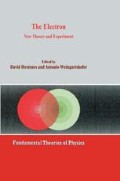Abstract
A modified form of Hestenes’s space-time version of Dirac’s equation is separated in spherical polar coordinates. The angular part of the solution spinor is derived in its most general form in terms of Gegenbauer polynomials and exponentials. One- and two-valued (multi-valued) spinors are obtained as a generalization of Weyl’s spherical harmonics with spin. The radial spinor equation defines a reduced real space-time algebra with one time and two space dimensions and displays symmetries which are hidden in the conventional matrix form. The superiority of this real valued Clifford algebraic formulation of the radial problem is demonstrated for the bound states of hydrogen-like atoms. The single-valued solutions turn out to be the ones of Darwin in a different representation.
One- and two-valued solutions together imply the unexpected discovery that the hydrogen atom in its states of lowest energy may realize the following values of its magnetic moment: μ = μ D and μ = μ D /\( \pi ,where {\mu _D} = \mu {}_{Darwin} = {1 \over 3}(1 + 2\gamma ){\mu _B},\) \( \gamma = \sqrt {1 - {\alpha ^2},} \) \( \alpha = {{{q^2}} \over {nc}},\) \( {\mu _B} = {\mu _{Bohr}} = {{\mid q\mid n} \over {2mc}}.\) Presumably it is an effect of the selfinteraction which seems to prefer the single-valued Darwin solution of the Dirac equation in the normal state of the hydrogen atom.
Access this chapter
Tax calculation will be finalised at checkout
Purchases are for personal use only
Preview
Unable to display preview. Download preview PDF.
References
Hestenes, D. (1975) ’Observables, Operators, and Complex Numbers in the Dirac Theory’, J. Math. Phys. 16, 556–572.
Weyl, H. (1930) The Theory of Groups and Quantum Mechanics, Dover, U.S.A..
Bopp, F. and Haag, R. (1950) ’Über die Mōglichkeit von Spinmodellen’, Z. Naturforschg. 5a, 644–653.
Erdélyi, A. (1953) Bateman Manuscript Project, Higher Transcendental Functions, Volume I, pp. 178–179, McGraw-Hill, New York.
Delanghe, R. and Sommen, F. (1986) ’Spingroups and spherical monogenics’ , in J.S.R. Chisholm and A.K.Commen (eds.), Clifford Algebras and Their Applications in Mathematical Physics, D. Reidel Publishing Company, Dordrecht, pp. 115–132.
Rose, M.E. (1961) Relativistic Electron Theory, John Wilney, New York, p. 159, equation 5.5..
Yvon, J. (1940) ’Équations de Dirac-Madelung’,J. Phys. et le Radium 1, 18–24.
Takabayasi, T. (1957) ’Relativistic Hydrodynamics of the Dirac Matter’, Prog. Theor. Phys. Suppl. 4, 1–80.
Hestenes, D. (1967) ’Real Spinor Fields’, J. Math. Phys. 8, 798–808, p. 805, equations (5.7)-(5.11).
Darwin, C. G. (1928) ’The Wave Equations of the Electron’, Proc. Roy. Soc. Lond., A118, 654–680.
Bethe, H. A. and Salpeter, E. E. (1957) Quantum Mechanics of One- and Two-Electron Atoms, Springer, Berlin, pp. 68–70.
Gurtler, R.W. (1972) ’Local observables in the Pauli and Dirac formulations of quantum theory’, Dissertation, Arizona State University, Appendix A2.
Babiker, M. and Loudon, R. (1983) ’Derivation of the Power-Zienau-Woolley Hamiltonian in Quantum Electrodynamics by Gauge Transformation’, Proc. Roy. Soc. Lond. A385, 439–460.
Author information
Authors and Affiliations
Editor information
Editors and Affiliations
Rights and permissions
Copyright information
© 1991 Kluwer Academic Publishers
About this chapter
Cite this chapter
Krüger, H. (1991). New Solutions of the Dirac Equation for Central Fields. In: Hestenes, D., Weingartshofer, A. (eds) The Electron. Fundamental Theories of Physics, vol 45. Springer, Dordrecht. https://doi.org/10.1007/978-94-011-3570-2_4
Download citation
DOI: https://doi.org/10.1007/978-94-011-3570-2_4
Publisher Name: Springer, Dordrecht
Print ISBN: 978-94-010-5582-6
Online ISBN: 978-94-011-3570-2
eBook Packages: Springer Book Archive

